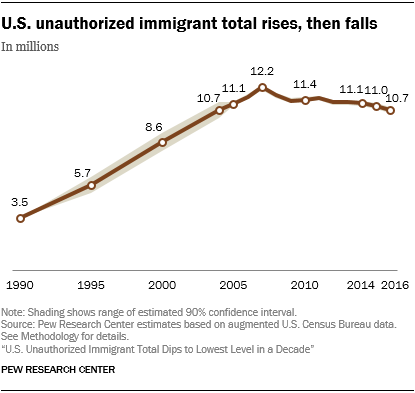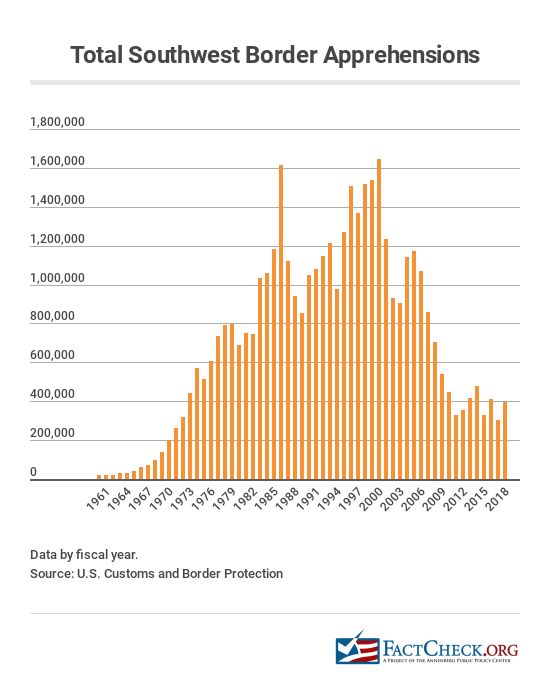
With the controversy over family separations, much of the political rhetoric in recent weeks has focused on illegal immigration. We thought it would be helpful to take a step back and look at some measures of illegal immigration in a larger context.
Illegal Immigration Statistics
Update, Jan. 9: We have updated these statistics to the most recent numbers available as of Jan. 9, 2019.
For example, how many immigrants live in the U.S. illegally, and how many are caught each year trying to cross the Southwest border? How many of them are families or unaccompanied children? And how have these statistics changed over time? Let’s take a look at the numbers.
How many immigrants are living in the U.S. illegally?
There were 12 million immigrants living in the country illegally as of January 2015, according to the most recent estimate from the Department of Homeland Security. The estimates from two independent groups are similar: The Pew Research Center estimates the number at 10.7 million in 2016, and the Center for Migration Studies says there were 10.8 million people in 2016 living in the U.S. illegally.
That would be about 3.3 percent to 3.7 percent of the total U.S. population in 2016 or 2015.
All three groups use Census Bureau data on the foreign-born or noncitizens and adjust to subtract the legal immigrant population.
DHS estimated that the growth of the illegal immigrant population had slowed considerably, saying the population increased by 470,000 per year from 2000 to 2007, but only by 70,000 per year from 2010 to 2015.
CMS found a decline in the undocumented population, and specifically those from Mexico, of about 1 million since 2010. And the Pew Research Center found a peak of 12.2 million in the population in 2007, and a decline since.

All three groups find Mexicans make up the majority of the undocumented population — 55 percent in 2015, according to DHS — but the number and share of Mexicans among this population has been declining in recent years.
Those living in the country illegally also have increasingly been here for 10 years or more. DHS says nearly 80 percent in 2015 have lived in the U.S. for more than a decade, and only 6 percent came to the country over the previous five years.
How many people are crossing the border illegally?
There’s no official measure of how many people succeed in illegally crossing the border, but authorities use the number of apprehensions to gauge changes in illegal immigration. Apprehensions on the Southwest border peaked in 2000 at 1.64 million and have generally declined since, totaling 396,579 in 2018.
Those numbers, which come from the U.S. Customs and Border Protection, are for fiscal years and date back to 1960.

That’s a 76 percent decline in the number of apprehensions between the peak in 2000 and 2018.
We can also look at how the figures have changed over the past several years.
Under the Obama administration, the yearly apprehensions on the Southwest border declined by 35 percent from calendar year 2008, the year before President Obama took office, through the end of 2016. In President Donald Trump’s first full year in office, the apprehensions declined by 43 percent, from calendar year 2016 to 2017.
On a monthly basis, the apprehensions decreased significantly during the first six months of Trump’s tenure and then began to rise. The number was actually higher in November (the most recent month for which the U.S. Customs and Border Protection has published figures) than it was when Trump was sworn in….READ THE REST
Here’s some recent Ben Shapiro comment on illegal immigration:
“THEY’RE ILLEGAL” – Ben Shapiro Tells Liberal Woman The Truth About Illegal Immigration In The US
The Illegal-Alien Crime Wave
Why can’t our immigration authorities deport the hordes of illegal felons in our cities?
Some of the most violent criminals at large today are illegal aliens. Yet in cities where the crime these aliens commit is highest, the police cannot use the most obvious tool to apprehend them: their immigration status. In Los Angeles, for example, dozens of members of a ruthless Salvadoran prison gang have sneaked back into town after having been deported for such crimes as murder, assault with a deadly weapon, and drug trafficking. Police officers know who they are and know that their mere presence in the country is a felony. Yet should a cop arrest an illegal gangbanger for felonious reentry, it is he who will be treated as a criminal, for violating the LAPD’s rule against enforcing immigration law.
The LAPD’s ban on immigration enforcement mirrors bans in immigrant-saturated cities around the country, from New York and Chicago to San Diego, Austin, and Houston. These “sanctuary policies” generally prohibit city employees, including the cops, from reporting immigration violations to federal authorities.
Such laws testify to the sheer political power of immigrant lobbies, a power so irresistible that police officials shrink from even mentioning the illegal-alien crime wave. “We can’t even talk about it,” says a frustrated LAPD captain. “People are afraid of a backlash from Hispanics.” Another LAPD commander in a predominantly Hispanic, gang-infested district sighs…READ MORE








